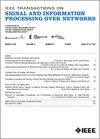基于梯度的随机点积图谱嵌入
IF 3
3区 计算机科学
Q2 ENGINEERING, ELECTRICAL & ELECTRONIC
IEEE Transactions on Signal and Information Processing over Networks
Pub Date : 2023-12-15
DOI:10.1109/TSIPN.2023.3343607
引用次数: 0
摘要
随机点积图(RDPG)是一种关系数据生成模型,节点通过低维欧几里得空间中的潜在向量表示。RDPG 的关键假设是,边缘形成概率由相应的潜在位置的点积给出。因此,从观测图中估算这些向量的嵌入任务通常被视为低阶矩阵因式分解问题。主要的邻接谱嵌入(ASE)具有可靠的统计特性,但它在形式上解决的是一个代理问题,而且计算量很大。在本文中,我们将介绍非凸优化的最新进展,并展示它们对 RDPG 推断的影响。我们提倡一阶梯度下降方法,以更好地解决嵌入问题,并有机地适应更广泛的实际网络嵌入应用。值得注意的是,我们认为除非约束因子矩阵具有正交列,否则有向图的 RDPG 嵌入会降低可解释性。因此,我们在由此产生的流形中开发了一种新的可行优化方法。我们利用合成和真实网络数据进行了可重复实验,证明了图表示学习框架的有效性。我们的开源算法实现具有可扩展性,而且与 ASE 不同,它们对缺失的边缘数据具有鲁棒性,并能跟踪流图中缓慢变化的潜在位置。本文章由计算机程序翻译,如有差异,请以英文原文为准。
Gradient-Based Spectral Embeddings of Random Dot Product Graphs
The Random Dot Product Graph (RDPG) is a generative model for relational data, where nodes are represented via latent vectors in low-dimensional Euclidean space. RDPGs crucially postulate that edge formation probabilities are given by the dot product of the corresponding latent positions. Accordingly, the
embedding
task of estimating these vectors from an observed graph is typically posed as a low-rank matrix factorization problem. The workhorse Adjacency Spectral Embedding (ASE) enjoys solid statistical properties, but it is formally solving a surrogate problem and can be computationally intensive. In this paper, we bring to bear recent advances in non-convex optimization and demonstrate their impact to RDPG inference. We advocate first-order gradient descent methods to better solve the embedding problem, and to organically accommodate broader network embedding applications of practical relevance. Notably, we argue that RDPG embeddings of directed graphs loose interpretability unless the factor matrices are constrained to have orthogonal columns. We thus develop a novel feasible optimization method in the resulting manifold. The effectiveness of the graph representation learning framework is demonstrated on reproducible experiments with both synthetic and real network data. Our open-source algorithm implementations are scalable, and unlike the ASE they are robust to missing edge data and can track slowly-varying latent positions from streaming graphs.
求助全文
通过发布文献求助,成功后即可免费获取论文全文。
去求助
来源期刊

IEEE Transactions on Signal and Information Processing over Networks
Computer Science-Computer Networks and Communications
CiteScore
5.80
自引率
12.50%
发文量
56
期刊介绍:
The IEEE Transactions on Signal and Information Processing over Networks publishes high-quality papers that extend the classical notions of processing of signals defined over vector spaces (e.g. time and space) to processing of signals and information (data) defined over networks, potentially dynamically varying. In signal processing over networks, the topology of the network may define structural relationships in the data, or may constrain processing of the data. Topics include distributed algorithms for filtering, detection, estimation, adaptation and learning, model selection, data fusion, and diffusion or evolution of information over such networks, and applications of distributed signal processing.
 求助内容:
求助内容: 应助结果提醒方式:
应助结果提醒方式:


